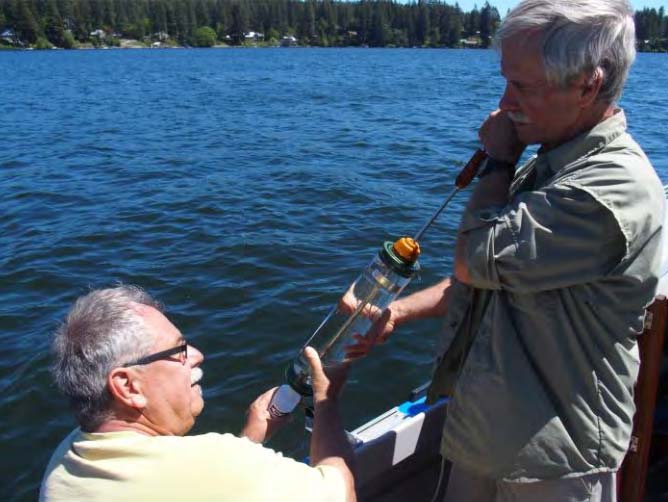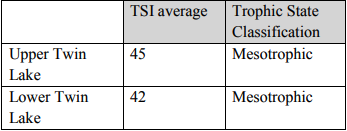Projects
Citizen Volunteer
Monitoring Program

This is a summary of the analysis from the water samples collected by the Citizen Volunteer Monitoring Program (CVMP). This program is run by the Idaho Department of Environmental Quality (DEQ). TLIA Board members have collected water samples from Twin Lakes since 1975. The prime objective of monitoring the water in Twin Lakes is to detect any significant change in the “Trophic state” of the lakes over time.
The trophic state of a lake is a classification of its biological productivity, which is the life-supporting capacity per unit volume of a lake. Eutrophication is the process by which excessive nutrients are introduced into a lake from land runoff. Over time, this causes a dense growth of plant life and death of animal life due to a lack of oxygen.
The three common trophic classifications are oligotrophic, mesotrophic, and eutrophic. Oligotrophic lakes are clear and blue, with very low levels of nutrients and algae. Mesotrophic lakes have moderate levels of nutrients and algae. Eutrophic lakes are green and murky, with higher amounts of nutrients and algae.
The concept of trophic state is based on the fact that changes in nutrient levels (measured by total phosphorus) causes changes in algal biomass (measured by chlorophyll a) which in turn causes changes in lake clarity (measured by Secchi disk transparency). Secchi disk transparency or water clarity measures the depth one can see into a lake. “Chlorophyll a” is a measure of the
Over the recent
Presented below are the Carlson trophic state index values for Twin Lakes. Summer averages (June – September) are used in the calculations. As seen from the trophic state index values, both upper and lower Twin Lakes can be classified as Mesotrophic. Mesotrophic is the middle range of productivity which is the desirable condition for both Twin lakes. The difference in TSI scores for the upper lake is slight and it still shows the productivity at the midpoint of the range for Mesotrophic (40 to 50). The Lower Lake shows no change and nearly breaks the threshold of improvement. The upper Twin Lake is less likely to achieve the lower end of the mesotrophic scale due to natural conditions (depth, vegetation, wind, and runoff). Again, it may take several years to stabilize the signal from the Upper Lake based on recent years of reduced sediment load.

